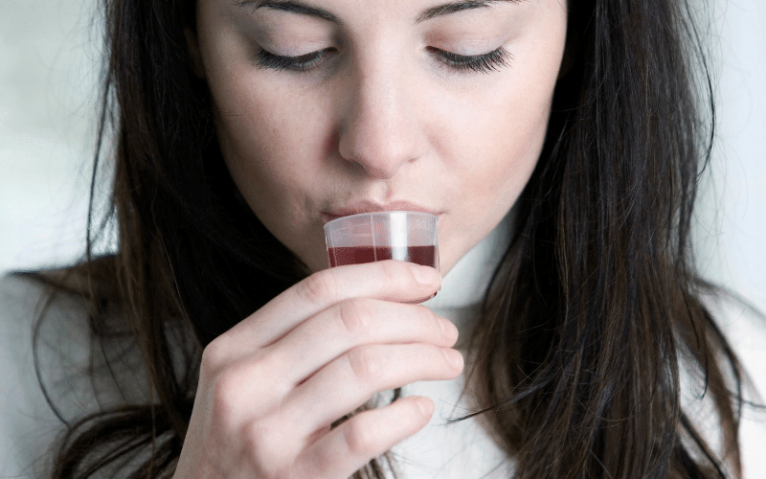Drinking some prescription-strength cough syrup was popular in the late 90s among children and teenagers, but today’s trend continues. Purple drank, sizzurp, or lean are all codeine-based cough syrup medicines that can produce euphoria and relaxation when misused. While it might not seem as dangerous as a heroin or cocaine addiction, it can still lead to adverse health effects.
What is Purple Drank?
Purple drank is a street name to the recreational drug created by mixing different prescription-strength cough syrups. Usually, people combine promethazine-codeine products, which are typically a deep purple color, hence the name. Then, they combine the syrup with a carbonated soft drink and a hard candy like a Jolly Rancher.
Most cough medicines with codeine are a Schedule V drug, making them lacking a prescription. However, since they have a moderate potential for addiction, people often misuse their medications.
To break it down, even more, codeine belongs to the opioid family, whereas promethazine is an antihistamine. These drugs are known to cause effects like euphoria, dizziness, memory loss, and hallucinations.
Side Effects of Purple Drank or Lean
Most people that sip purple drank experience feelings of euphoria and dissociation from their bodies. The effects can last about three to six hours, depending on the dosage and your health condition. Codeine, promethazine, dextromethorphan (DXM) are all cough suppressant prescription opioids that suppress the central nervous system causing relaxation and euphoric feelings.
However, it’s unclear how many people misuse prescription cough syrups because these trends are not as tracked as other drugs. The Monitoring the Future Report estimates that between 2 to 4 percent of students in 8th to 12th grade are misusing cough and cold medications to get high.
What’s even more dangerous is that it’s impossible to precisely know what people add to their drug cocktails. Because of this, the risk of overdose is higher than with non-cocktail drugs. But, we can still analyze the leading players in purple drank.
Promethazine Effects
An anti-vomiting and sedative medication that can be helpful when used as prescribed. Promethazine doesn’t create euphoria by itself, but it does when mixed with codeine or alcohol. When taken in large doses, it can cause:
- Abnormal heart rhythm
- Drastic changes in blood pressure
- Dry skin and mucous membranes
- Hallucinations
- Seizures
- Breathing problems
Codeine
Our bodies metabolize codeine cough syrup into morphine, which causes feelings of analgesia and euphoria. Like many opioids, codeine can have severe, long-lasting effects in our body, including:
- Brain damage
- Dizziness
- Redness of arms, face, neck, and upper chest
- Shortness of breath
- Stopping of the heart
Signs of Use
Purple drank became a cultural phenomenon because famous people, including celebrities, rappers, and athletes, all used it. For example, the singer and rapper Mac Miller, who later died of a drug overdose, had spoken about his addiction to purple drank. You can even hear references to it on songs and music videos, including those by famous hip hop artists like Lil Wayne and DJ Screw.
Because cough syrups are available both over-the-counter and with a prescription, people think they’re entirely safe to use. However, they’re not educated about the life-threatening effects of misusing or abusing it.
If you’re trying to figure out if your child or loved one is sipping purple drank, watch for these signs:
- Noticing empty bottles of cough syrups
- Finding empty styrofoam cups, soda, and candy
- Changes in personality and behaviors
- Changes in sleep patterns
- Sudden change in friends
- Loss of interest in school or social activities
Can Someone Get Addicted?
The short answer is yes. Addiction to purple drank is possible, although it won’t happen overnight. Codeine is a habit-forming opioid medication, which means that misuse can lead to dependence and addiction. With continuous use, people can develop a tolerance and need more of this potent drug cocktail to experience the same feelings; this places them at a higher risk of overdose.
One way to notice an addiction to purple drank is by pinpointing withdrawal symptoms whenever they stop drinking it, such as:
- Anxiety
- Diarrhea
- Irritability
- Loss of appetite
- Nausea and vomiting
- Sleep problems
- Teary eyes
Withdrawal from purple drank use can be very uncomfortable, but it is not life-threatening. Although complications can occur, that pose a potential danger. However, because these symptoms are uncomfortable, people are likely to take the same dose of the drug again. When this happens, your body might not be able to tolerate the exact amount and cause an overdose. Signs of purple drank overdose include:
- Bluish fingernails and lips
- Slow and labored breathing
- Cold, clammy skin
- Confusion
- Dizziness
- Loss of consciousness
- Tiny pupils
- High or low blood pressure
- Weak pulse
- Coma
Getting Help
If you or a loved one is misusing cough syrups, it’s paramount that you seek help and consult with an addiction specialist. If you’re struggling with an addiction, you might need long-term recovery support, following a detox program to stay off purple drank or any other addictive substances. Addiction treatment might be:
- Inpatient rehab
- Intensive outpatient program
- Medication-assisted treatment
- Outpatient therapy
- Aftercare relapse prevention
- Support groups
- Life skills development
Remember, getting help for substance abuse is one of the bravest things you can do for yourself. At Lighthouse Recovery Institute, our addiction programs offer a comprehensive approach tailored to meet your unique needs and help you walk toward long-term recovery.









